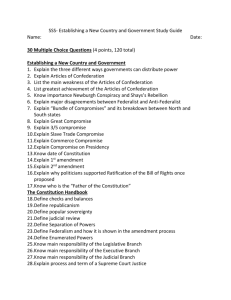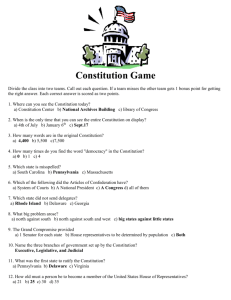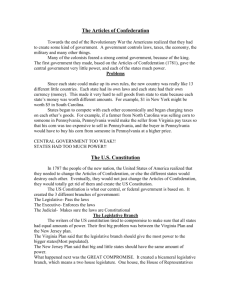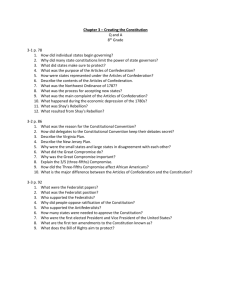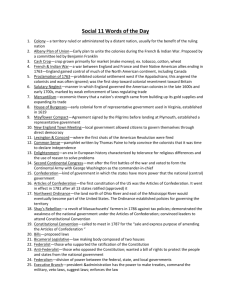Print › CPA Midterm Terms | Quizlet
advertisement
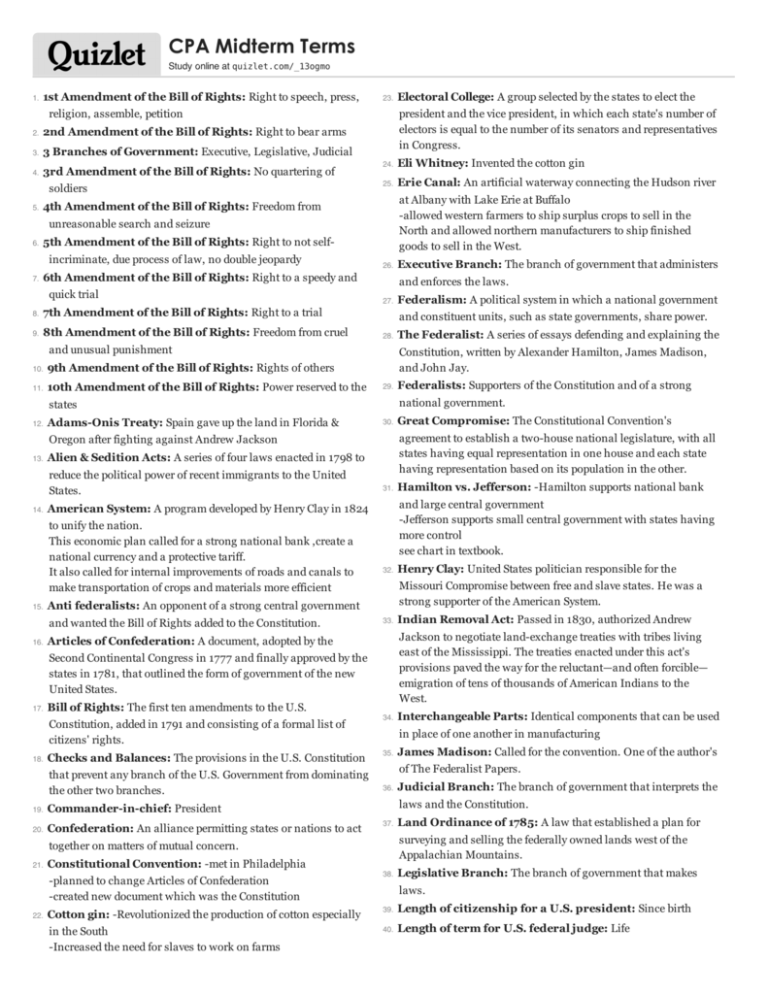
CPA Midterm Terms Study online at quizlet.com/_13ogmo 1. 1st Amendment of the Bill of Rights: Right to speech, press, 23. religion, assemble, petition 2. 2nd Amendment of the Bill of Rights: Right to bear arms 3. 3 Branches of Government: Executive, Legislative, Judicial 4. 3rd Amendment of the Bill of Rights: No quartering of soldiers 5. president and the vice president, in which each state's number of electors is equal to the number of its senators and representatives in Congress. 24. Eli Whitney: Invented the cotton gin 25. Erie Canal: An artificial waterway connecting the Hudson river at Albany with Lake Erie at Buffalo -allowed western farmers to ship surplus crops to sell in the North and allowed northern manufacturers to ship finished goods to sell in the West. 4th Amendment of the Bill of Rights: Freedom from unreasonable search and seizure 6. 5th Amendment of the Bill of Rights: Right to not selfincriminate, due process of law, no double jeopardy 7. 26. 6th Amendment of the Bill of Rights: Right to a speedy and quick trial 8. 7th Amendment of the Bill of Rights: Right to a trial 9. 8th Amendment of the Bill of Rights: Freedom from cruel 9th Amendment of the Bill of Rights: Rights of others 11. 10th Amendment of the Bill of Rights: Power reserved to the 27. Adams-Onis Treaty: Spain gave up the land in Florida & 28. 29. Federalists: Supporters of the Constitution and of a strong 30. Great Compromise: The Constitutional Convention's national government. agreement to establish a two-house national legislature, with all states having equal representation in one house and each state having representation based on its population in the other. Alien & Sedition Acts: A series of four laws enacted in 1798 to reduce the political power of recent immigrants to the United States. 14. 15. 32. 18. 33. 20. Bill of Rights: The first ten amendments to the U.S. Constitution, added in 1791 and consisting of a formal list of citizens' rights. 34. Interchangeable Parts: Identical components that can be used Checks and Balances: The provisions in the U.S. Constitution 35. James Madison: Called for the convention. One of the author's 36. Judicial Branch: The branch of government that interprets the 37. Land Ordinance of 1785: A law that established a plan for in place of one another in manufacturing of The Federalist Papers. laws and the Constitution. Commander-in-chief: President Confederation: An alliance permitting states or nations to act surveying and selling the federally owned lands west of the Appalachian Mountains. together on matters of mutual concern. 21. 22. Indian Removal Act: Passed in 1830, authorized Andrew Jackson to negotiate land-exchange treaties with tribes living east of the Mississippi. The treaties enacted under this act's provisions paved the way for the reluctant—and often forcible— emigration of tens of thousands of American Indians to the West. Articles of Confederation: A document, adopted by the that prevent any branch of the U.S. Government from dominating the other two branches. 19. Henry Clay: United States politician responsible for the Missouri Compromise between free and slave states. He was a strong supporter of the American System. Second Continental Congress in 1777 and finally approved by the states in 1781, that outlined the form of government of the new United States. 17. Hamilton vs. Jefferson: -Hamilton supports national bank and large central government -Jefferson supports small central government with states having more control see chart in textbook. Anti federalists: An opponent of a strong central government and wanted the Bill of Rights added to the Constitution. 16. 31. American System: A program developed by Henry Clay in 1824 to unify the nation. This economic plan called for a strong national bank ,create a national currency and a protective tariff. It also called for internal improvements of roads and canals to make transportation of crops and materials more efficient The Federalist: A series of essays defending and explaining the Constitution, written by Alexander Hamilton, James Madison, and John Jay. Oregon after fighting against Andrew Jackson 13. Federalism: A political system in which a national government and constituent units, such as state governments, share power. states 12. Executive Branch: The branch of government that administers and enforces the laws. and unusual punishment 10. Electoral College: A group selected by the states to elect the Constitutional Convention: -met in Philadelphia -planned to change Articles of Confederation -created new document which was the Constitution 38. Legislative Branch: The branch of government that makes Cotton gin: -Revolutionized the production of cotton especially 39. Length of citizenship for a U.S. president: Since birth in the South -Increased the need for slaves to work on farms 40. Length of term for U.S. federal judge: Life laws. 41. Marbury v. Madison: 1803 case in which the Supreme Court ruled, by Supreme Court Chief Justice John Marshall, that it had the power to abolish legislative acts by declaring them unconstitutional; this power came to be known as judicial review. 42. 45. Three-Fifths Compromise: The Constitutional Convention's agreement to count three-fifths of a state's slaves as population for purposes of representation and taxation. 63. Trail of Tears: The tragic journey of the Cherokee people from their home land to Indian territory between 1838 and 1839, thousands of Cherokees died. 64. Virginia Plan: Plan for a large central government with representatives based on the states population. Favored by large states. Northwest Ordinance of 1787: A law that established a 66. XYZ Affair: A 1797 incident in which French officials Nullification Theory: Ability for states to declare a federal law Problems (weakenesses) with the Articles of Ratification: The official approval of the Constitution, or of an 49. Republic: A government in which the citizens rule through 50. Republicanism: The belief that government should be based on 51. Requirement to be a U.S Senator or Representative: U.S. 52. Requirements for Congress to override a veto: Each house 53. Roger Sherman: Created the Great Compromise. 54. Shays's Rebellion: An uprising of debt-ridden Massachusetts 55. Spoils System: System in which incoming political parties amendment, by the states. elected representatives. the consent of the people. Citizen, live in the state he or she represents, at least 25 years old must pass the bill by a 2/3 majority. farmers protesting increased state taxes. throw out former government workers and replace them with their own friends Structure of government under Articles of Confederation: -able to declare war -sign treaties/make alliances -all states represented equally in Congress -9 out of 13 states had to agree to make changes Tariff of Abominations: Tariff passed by Congress in 1828 that favored manufacturing in the North and was hated by the South 58. 62. Whiskey Rebellion: Demonstrates ability for the U.S. 48. 57. Term length of a U.S. Senator: 6 years 65. Confederation: - States did not support national issues - Congress lacked the power to tax which would help pay down national debt - Lack of ability to enforce national laws - No army or navy - No common currency - No central court system 56. 61. each state having the same amount of representatives/votes. Favored by the small states null and void if law does not apply to their state 47. Term length of a Representative: 2 years New Jersey Plan: Plan for a small central government with procedure for the admission of new states to the Union. 46. 60. Movement of capital to Washington D.C.: -wanted support from the South for the national bank -proposed by Hamilton 44. Term length of a president: 4 years Monroe Doctrine: (1823) A political policy of the United States by President James Monroe that states the Western Hemisphere is closed to European interference. It declared that the Western Hemisphere was off limits to colonization by other powers 43. 59. Tecumseh: Native American leader who fought against the US during the War of 1812 government to enforce excise tax within states. demanded a bribe from U.S. diplomats.
